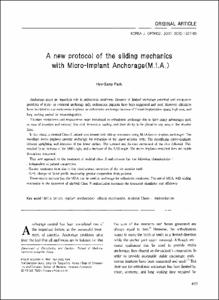A new protocol of the sliding mechanics with Micro-Implant Anchorage(M.I.A.)
- Keimyung Author(s)
- Park, Hyo Sang
- Department
- Dept. of Dentistry (치과학)
- Journal Title
- 대한치과교정학회지
- Issued Date
- 2000
- Volume
- 30
- Issue
- 6
- Abstract
- Anchorage plays an important role in orthodontic treatment. Because of limited anchorage potential and acceptance problems of intra- or extraoral anchorage aids, endosseous implants have been suggested and used. However, clinicians have hesitated to use endosseous implants as orthodontic anchorage because of limited implantation space, high cost, and long waiting period for osseointegration.
Titanium miniscrews and microscrews were introduced as orthodontic anchorage due to their many advantages such as ease of insertion and removal, low cost, immediate loading, and their ability to be placed in any area of the alveolar bone.
In this study, a skeletal Class II patient was treaten with sliding mechanics using M.I.A.(micro-implant anchorage), The maxillary micro-implants provide anchorage for retraction of the upper anterior teeth. The mandibular micro-implants induced uprighting and intrusion of the lower molars. The upward and forward movement of the chin followed. This resulted in an increase of the SNB angle, and a decrease of the ANB angle. The micro-implants remained firm and stable throughout treatment.
This new approach to the treatment of skeletal class II malocclusion has the following characteristics :
. Independent of patient cooperation.
. Shorter treatment time due to the simultaneous retraction of the six anterior teeth
. Early change of focial profile motivating greater cooperation from patients
These results indicate that the M.I.A. can be used as anchorage for orthodontic treatment. The use of M.I.A. with sliding mechanics in the treatment of skeletal Class II malocclusion increases the treatment simplicity and efficiency.
고정원의 조절은 교정치료에 있어서 매우 중요한 요소로 이를 보강하기 위한 많은 노력이 있어 왔다. 골융합성 임프란트의 경우 확실한 고정원으로서 가능성이 인정되고 있고, 또 임상에서 시도되고 있다. 그러나 임프란트를 매식하기 위해서는 무치악이 존재해야 하거나 하악구치 후방부위에 식립해야 하는 등 장소의 제약이 있고, 값이 비싸며, 골융합을 위하여 기다리는 시간이 필요하다는 등의 단점으로 인하여 보편화되고 있지는 않다.
최근 몇몇 임상가에 의하여 수술용 titanium microscrew나 miniscrew를 교정치료시의 고정원으로 사용하려는 시도가 있었는데, 이것은 골융합성 임프란트보다 수술이 간단하며, 가격이 저렴하고, 치조골 어느 부위든지 식립할 수 있다는 장점이 있다.
저자는 M.I.A.(Micro-Implant Anchorage)를 고정원으로 사용한 sliding mechanics를 통하여 골격성 Ⅱ급 부정교합자를 치료하였다. 상악의 M.I.A.는 상악전치의 후방견인의 고정원으로 사용되었고 하악의 M.I.A.는 하악 제1대구치의 직립과 제2대구치의 압하이동의 고정 원으로 사용되었다. 하악 구치가 직립됨에 따라 하악골의 전상방 회전이 일어나 SNB각의 증가로 이어지고 ANB각의 감소를 가져왔다. M.I.A.는 치료 전기간동안 안정되게 유지되어 교정치료의 고정원으로서의 가능성을 확인시켜 주었다.
M.I.A.를 고정원으로 사용한 sliding mechanics를 통하여 골격성 Ⅱ급 부정교합자를 치료하는 새로운 접근법은 환자의 협조도에 의존하지 않고 치료할 수 있고, 비교적 빠른 시기에 많은 안모의 변화를 가져와 환자의 협조도를 끌어 낼 수 있다. 그리고 상악 6전치를 동시에 후방견인하므로 치료기간을 줄일 수 있으며 호선의 교환이 적어 chair time이 짧다.
이런 결과로 미루어 볼 때 MIA는 치아이동의 고정 원으로 역할을 할 수 있을 것으로 생각되고, MIA를 고정원으로 이용한 sliding mechanics를 통한 교정치료는 골격성 Ⅱ급 부정교합의 치료에 있어서 쉽고 효율적인 치료법으로 생각된다.
- Alternative Title
- Micro-Implant Anchorage(MIA)를 이용한 Sliding mechancis
- Keimyung Author(s)(Kor)
- 박효상
- Publisher
- School of Medicine
- Citation
- Hyo-Sang Park. (2000). A new protocol of the sliding mechanics with Micro-Implant Anchorage(M.I.A.). 대한치과교정학회지, 30(6), 677–685.
- Type
- Article
- ISSN
- 1225-5610
- Appears in Collections:
- 1. School of Medicine (의과대학) > Dept. of Dentistry (치과학)
- 파일 목록
-
-
Download
 oak-bbb-3791.pdf
기타 데이터 / 877.95 kB / Adobe PDF
oak-bbb-3791.pdf
기타 데이터 / 877.95 kB / Adobe PDF
-
Items in Repository are protected by copyright, with all rights reserved, unless otherwise indicated.